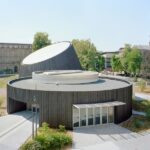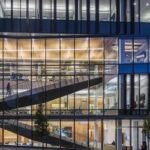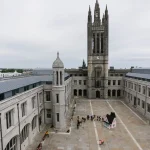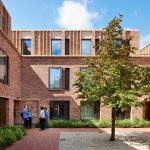Campus of University Saint-Charles, Historic Montpellier Building, Architect, Architecture Images
Campus of University Saint-Charles in Montpellier, France
French University Campus design by Hellin-Sebbag, Architectes
8 Feb 2013
Campus of University Saint-Charles in Montpellier
Design: Hellin-Sebbag Architectes
Location: Languedoc-Roussillon région capital, south of France
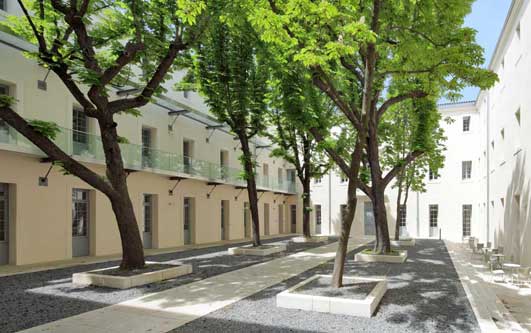
photograph © Hellin-Sebbag ; photo Benoît Wehrlé
Campus of University Saint-Charles in Montpellier by Hellin-Sebbag
‘Transparency, light and ease of movement’
Design: Brigitte Hellin and Hilda Sebbag
In autumn 2011, architects Brigitte Hellin and Hilda Sebbag completed the first phase in the transformation of a seventeenth-century hospital into a university campus, close to the historic centre of Montpellier.
The second phase on the same site will convert a building, erected in 1768 to house the incurably sick, into a Maison des Sciences de l’Homme and a department of archaeology (tender imminent).
This vast renovation and conversion covers an area of almost 15,000 square metres. The third phase will concern a new extension over an area of 3,500 square metres.
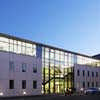

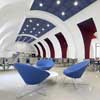
photographs © Hellin-Sebbag photo Jean-Pierre Rocher
Phase 1
Conversion of the 17th-century hospital
STATEMENT OF INTENT
The assignment was to convert a seventeenth-century hospital and listed building into a university with the modern functionality that a university requires.
A SYMMETRICAL STRUCTURE
The main building, the Hôpital Général, comprises two courtyards located symmetrically along an axis that is materialised on the ground floor and first floor by a thick dividing wall. This wall separates the body of the main building lengthwise into two closed areas: the “women’s wing” and the “men’s wing”.
So that the 1,500 people who will use the building can move around freely – an important factor for the proper functioning of the university – we chose to cut through this wall at ground-floor level and replace it with pillars at first-floor level. This becomes the pivotal element of the entire building, with large zones extending from one side to the other: the cafeteria on the ground floor, administration on the first floor, and the library on the second floor.
The axis of symmetry is thereby conserved, but this symmetry is structured around the open spaces that connect the different zones, and no longer around a solid wall that divides them. So as to reverse the entry sequence, the new foyer is located opposite the chapel which, while separate from the university, remains part of the whole. By aligning the entrance with the axis of the building, the geometric purity of its layout is restored. As specified in the brief, the building is now accessed from the Esplanade and no longer from Place Albert Ier.
By “opening up” the building this way, what was once a barrier is now fully integrated into the surrounding area.
THE ENTRANCE FACADE
The facades for the second floor and central section, which will later be extended, have been replaced by a glazed curtain wall, allowing light into the foyer and the library respectively.
As a contemporary counterpart to the existing staircase by the architect Giral, which has been conserved, a monumental staircase in white precast concrete, in addition to a lift, has been built in the new foyer. It extends, as though suspended, over three levels and leads directly to the offices on the first floor and to the library on the second floor.

photograph © Hellin-Sebbag ; photo Benoît Wehrlé
THE TWO COURTYARDS
The even spacing of the windows in the facades onto the two courtyards has been conserved; openings above the breast wall are used as French windows to give access to the courtyard at ground-floor level, and on the first floor to the new passageways. These lightweight structures, which are supported by metal brackets embedded in the stone walls, have white concrete floors, a structural glass railing, and are protected by a glass canopy.
The two symmetrical courtyards, now connected by the passage created in the ground-floor central wing, have been landscaped with the utmost care, with precast, decorative concrete paving slabs along the perimeter, fine gravel under the trees for permeability, and sunken lights.
The magnificent, centennial chestnut trees provide welcome shade in summer. The original plane trees, because of disease, have been replaced by young trees, making this a sunnier courtyard which the students particularly appreciate in winter.
THE CAFETERIA
Colour brings the new architecture to the fore, with a sound-absorbing ceiling that mirrors the original semicircular vaults highlighted in blue on the “plane tree” side and in red on the “chestnut tree” side. Blue and red stripes of varying widths identify the openings made in the one-metre thick wall to connect the two areas. Service ducts for the cafeteria and kitchens are incorporated through the end walls which are lined with acoustic panels in perforated wood.
THE LECTURE HALLS
Conserving the ribbed vaults on the entire ground floor, and specifically in the lecture halls, imposed innovative solutions for fluid and electrical services.
– creation of conduits at ground-floor level for water, heating, electricity and ventilation installations
– subtle integration of audiovisual equipment and lighting
Acoustic comfort was achieved by means of suspended square tiles that respect the geometry of the vaults.
MAJOR RESTRUCTURING WORK AT LOW COST
The existing floors were either consolidated or demolished and cast in reinforced concrete.
For the facades, having demolished incoherent volumes and elements, eliminated incompatible materials, reinforced through injection, and removed existing joinery, we focused on reproducing the regular spacing of the openings and frames, and the horizontal mouldings perpendicular to each floor.
The existing roofing was removed to restore the original 37.5% pitch and barrel tiles.
These mammoth works were completed in 36 months at the very low cost of €1,280 exc. VAT/sq m of floor area, which also explains the sobriety of the materials.
HOW DID THE RENOVATION OF A HISTORIC BUILDING INFLUENCE OUR WORK?
The first time we visited the site, our instinct was to take to our heels and run as far away as possible from this dark, oppressive mass. How did this former hospice/prison with its drab and dilapidated facades become a listed building? Yet once we had got over our initial impression, we could see that certain proportions were indeed beautiful – the two rectangular courtyards that structure the building, the hidden majesty of the vaulted ground floor – a beauty we were determined to reveal.
A lesson in humility
Experience gained through previous renovation projects had taught us not to wipe the slate clean but to respect what is already there, even when this means a lowly 1960s building, erected in haste.
For what would be our first encounter with a heritage building, we knew our analysis must take in a much wider historical context than our own; that we must travel through time to rid it of the sediment of centuries and conserve only its essence.
When, as with the northern facade onto the Esplanade, nothing of the original structure remained, we could allow ourselves bold choices with structural glazing, and a triple-height foyer traversed by a dissymmetric staircase in concrete and steel.
In contrast, we impinged lightly on the courtyards, with their handsome proportions, and the vaulted ground-floor spaces than had this been a contemporary project, at the same time finely tailoring our work away from flourish and towards a philosophy of “less is more.”
Verticality This project was also our first experience of such vertical proportions, with heights ranging from 3.50 metres to 4.80 metres under the vaults. Light entered through a small number of high, narrow openings which at first seemed insufficient, only for us to discover the magnificent ensemble of forms they created in the Mediterranean light; an ensemble different to that of the modern movement, more familiar to us, but equally accomplished and correct.
PROJECT: Saint-Charles university campus: Hôpital Général – Phase 1
Conversion of a 17th-century hospital and listed building into a university
CLIENT: State – Ministry of Education and Research Montpellier Education Authority
PROJECT MANAGEMENT:
HELLIN-SEBBAG, ARCHITECTES ASSOCIÉS (Paris- Montpellier) Main contractor
GEC INGÉNIERIE, Quantity surveyor, and BET T.C.E.
FABRICA TRACEORUM, Heritage architect
BETS AIGOIN, Heritage structure
CABINET LE DOUARIN, Heritage quantity surveyor
BRIEF: Facilities for undergraduate students and researchers at the Paul Valéry Department of Literature (University of Montpellier 3): classrooms, lecture halls, offices, university library and cafeteria
SITE ADDRESS: Rue du Professeur Henri Serres and Place Albert 1er – 34000 Montpellier
AREA: 10,000 sqm net floor area
SCHEDULE: Phase 1: site work 36 months – handover September 2011
COST: €12.8 M exc. VAT at June 2008
PHOTOGRAPHY: Jean-Pierre PORCHER
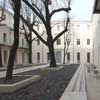

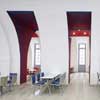
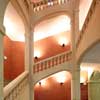
photographs © Hellin-Sebbag, photo Jean-Pierre Rocher
Phase 2
Conversion of the Aile des Incurables
In a second phase, the Aile des Incurables, on the same site, will be converted into a Maison des Sciences de l’Homme and a department of archaeology. The building will provide, on the two upper floors, workspace for researchers and facilities for hosting international symposiums.
This will require the creation, at ground-floor level, of seminar rooms and a lecture theatre… a seemingly impossible task given the dimensions and load-bearing structure of this eighteenth-century building. The site does, however, offer the advantage of its 5.30 metre ceiling height, where tiered seating for 100 people can be inserted in the 10.50 metre-wide central wing.
Extending the lecture theatre across the full width of this wing, adjacent to the entrance hall, means there can be no indoor circulation to the other areas. Our solution is to add an enclosed gallery to the courtyard facade. This gallery functions much as a winter garden; glass louvres can be opened and closed to allow air to circulate in summer and heat to accumulate in winter. As well as allowing the building’s users to circulate, sheltered from wind or rain, the gallery provides a natural meeting point for the entire wing.
Unlike the Hôpital Général, the Aile des Incurables is a “noble” stone construction with numerous decorative features such as medallions, string courses and sculpted cornices that must be restored. The small extension (200 sq m) is entirely sympathetic with the original building in its transparency and lightweight steel frame, as well as the glass louvres through which the renovated facade remains fully visible.
PROJECT: Saint-Charles university campus: Bâtiment des Incurables – Phase 2
Conversion of an 18th-century hospital wing and listed building into a university
CLIENT: State – Ministry of Education and Research Montpellier Education Authority
PROJECT MANAGEMENT:
HELLIN-SEBBAG, ARCHITECTES ASSOCIÉS (Paris- Montpellier): Main contractor
BETS AIGOIN: Structure
GEC Ingénierie: Fluid engineering
FABRICA TRACEORUM: Heritage architect
CABINET LE DOUARIN: Quantity surveyor
BRIEF: Maison des Sciences de l’Homme and Department of Archaeology for University of Montpellier 3. Lecture theatre, seminar rooms, university press, workspaces to be shared by researchers in social sciences, humanities and archaeology.
SITE ADDRESS: Rue du Professeur Henri Serres and Rue Auguste Broussonnet -34000 Montpellier
AREA: 4,687 sqm net floor area
SCHEDULE: Tender in progress (bidding documents). Works: Jul 2013
PROVISIONAL COST ESTIMATE: €8.52 M exc. VAT at Feb. 2009
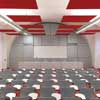
photograph © Hellin-Sebbag, photo Jean-Pierre Rocher
Campus of University Saint-Charles in Montpellier images / information from Hellin-Sebbag Architectes
Hellin-Sebbag architectes associés
Location: Rue du Professeur Henri Serres and Rue Auguste Broussonnet, 34000 Montpellier, France
New Buildings in France
French Architectural Projects
French Architect Offices – design firm listings
Paris Architecture Tours by e-architect
17 Sep 2017
Humanities Research Center Building at Campus of University Saint-Charles, Montpellier
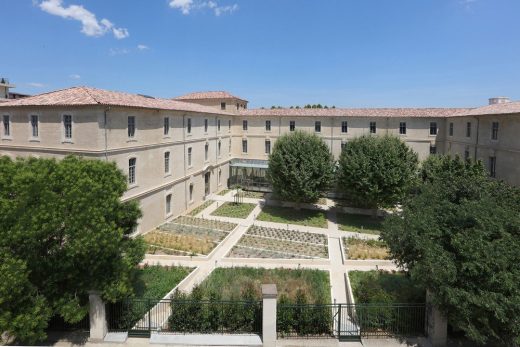
photograph © Hellin-Sebbag, photo Benoît Wehrlé
Campus of University Saint-Charles Montpellier
Delivered in 2011, the first phase converted the general hospital into university buildings for graduates and researchers in the Faculty of Humanities, Paul Valéry University.
Montpellier Buildings
Pierrevives Montpellier
Design: Zaha Hadid Architects
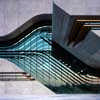
photo © Hélène Binet
Pierrevives Montpellier by Zaha Hadid
La Grande Motte, south east of Montpellier
N+B Architectes
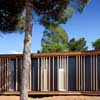
photograph : Paul Kozlowski
La Grande Motte Montpellier
RBC Design Center
Ateliers Jean Nouvel
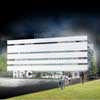
image © Ateliers Jean Nouvel
RBC Design Center Montpellier
Pierre Vives
Zaha Hadid Architects
picture from architects
Comments / photos for the Campus of University Saint-Charles in Montpellier page welcome

